Introduction
Specifications and Features
Sigma is one of the few truly independent lens makers left, and while it’s often rumored they that may make lenses for other brands, the company’s Art series lenses are clearly targeting the finest models from some of the biggest names in the industry. Following the introduction of the 35mm and 50mm, the 24mm DG HSM A is the third premium f/1.4 Art series prime in Sigma’s Global Vision revamp.
As a highly-complex 15-element design, it features no less than seven low-dispersion glass elements to reduce troublesome chromatic aberrations, while the use of two aspheres helps correct coma and distortion as well as reduces the size and weight of the lens. Like the 35mm and 50mm Art series models, autofocus uses a sonic-type motor that offers real-time manual override. Externally, the lens features a mix of metal alloys and a Thermally Stable Composite (TSC) material in the construction.
With one of the longest flange focal distances in 35mm format, Nikon F-mount models are usually the first to be introduced, as once the design has been finalized, it’s easier to accommodate shorter-register mounts. Be that as it may, the 24mm f/1.4 DG HSM Art was originally available in a Canon fitting. Interestingly, Sigma offers a (chargeable) mount conversion service, allowing the lens to fit a different camera brand should you decide to switch in the future.
The new Nikon-fit model focuses to 9.84” (25cm), and with a 77mm accessory thread, measures 3.35 x 3.55” (85 x 90.2mm) and weighs 1.4 lb (665g). It is available now at around $849 (USD), around $1350 less than the Nikon equivalent.
- 15 elements arranged in 11 groups
- Seven ED elements
- Two aspheres
- Super multi-coating to reduce ghosting and flare
- Sonic-type HSM with MF override
- 77mm filter diameter
- Sigma USB dock-compatible
Measurements: Excellent optical performance
With a DxO Mark lens score of 38 points on the Nikon D810, the Sigma 24mm F1.4 DG HSM A is a superb performer and is the best-performing 24mm Nikon mount in our database, regardless of price or maximum aperture (although we’ve yet to test the recently-announced AF-S Nikkor 24mm f1.8). Despite this, it is only narrowly the best, as both the Zeiss T* 25mm f2 and Nikon AF-S Nikkor 24mm f1.4G ED are excellent performers — particularly the Zeiss, which is practically the Sigma’s equal.
Comparison 1: Sigma 24mm f1.4 DG HSM A vs. Zeiss Distagon T* 25mm f2 ZF.2 vs. Nikon AFS Nikkor 24mm f1.4G ED: Excellent all round performer
The autofocus Sigma is a superb performer, but the manual-focus Zeiss is certainly on par optically. However, at around two-thirds of a T-stop slower, manual focus, and carrying an $850 premium, it’s not going to appeal to everyone. It narrowly misses the top slot by virtue of the slightly higher distortion and vignetting, but it has lower lateral chromatic aberration (although admittedly it is an f/2.0, after all). However, the Sigma is as sharp in the center at f/1.4 as the Zeiss is at f/2.0, and when stopped down to f/2.0 it is sharper, though not at the periphery. The Nikon, on the other hand, doesn’t really come close wide-open or f/2.0 except perhaps in the outer field. The Nikkor can be commended for its uniformity, but it’s noticeably less sharp in the center. Stopped down further to f/2.8, and there’s little to differentiate among them in sharpness, though in the lab the Sigma and Zeiss both have the edge.
Comparison 2: Sigma 24mm f1.4 DG HSM A vs. Samyang 24mm f1.4 ED AS UMC Nikon vs. Zeiss T* Distagon 25mm f2.8 ZF.2 Nikon
Pitched at against the accessibly-priced ($600) Samyang 24mm f1.4 and the Zeiss 25mm f2.8 (around $1000), and the Sigma still looks attractive. Not that the manual-focus Samyang isn’t a good performer — it is. While the Sigma is sharper at f/1.4 and f/2.0, the Samyang is close by f/2.8 and closer still by f4/, though it isn’t until f/11 that all three share similar sharpness levels (and profiles). The Zeiss is disappointing over the f/2.8-8 range, at least at the edges and corners. Centrally, sharpness is quite good but, surprisingly in a lens like this, it shows quite strong astigmatism and field curvature, and has high levels of chromatic aberration. The short minimum focus of the Zeiss allows some novel usage, but while the Samyang lacks the build of the Zeiss, the latter has noticeable vignetting and high levels of distortion.
Conclusion
Sigma is undoubtedly disrupting the market. Although we can’t really comment on the handling, AF operation, or build, the optical quality is equal, and in some cases superior, to the big brand names. That in itself wouldn’t be so disruptive if there weren’t such a price disparity. The fact that the Sigma 24mm f1.4 is available at around or more than half the price of the Nikon and Zeiss models and can compete with the more affordable options makes it all the more attractive. At just $849 currently, it is a thoroughly compelling choice, and particularly so if looking for an AF model.


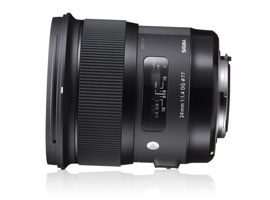



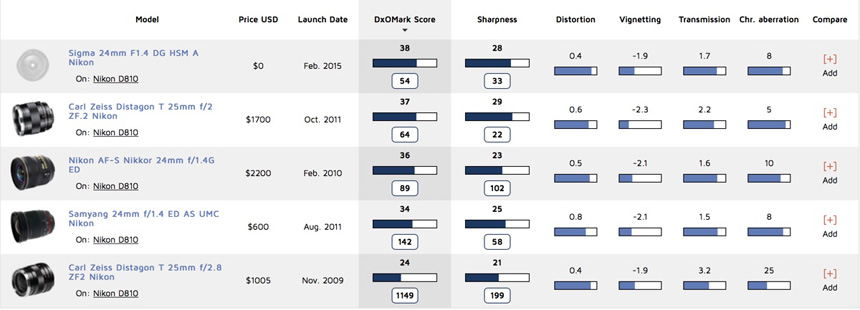
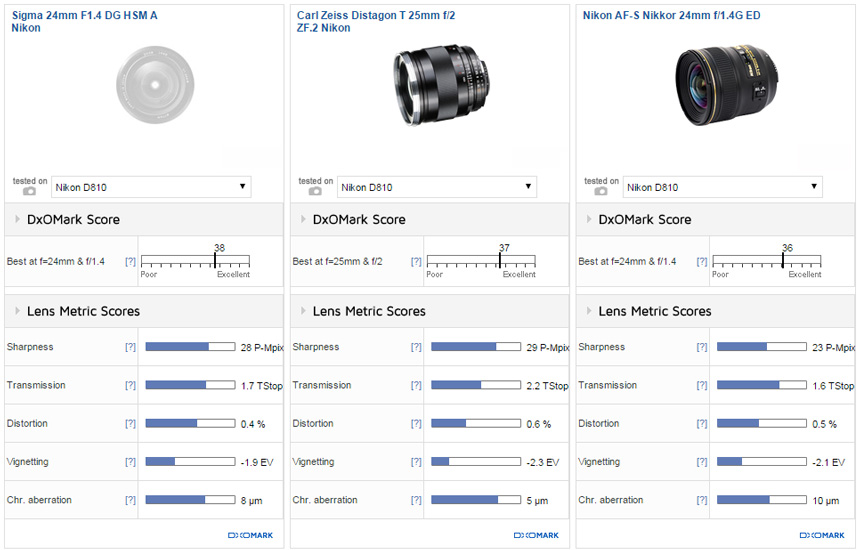
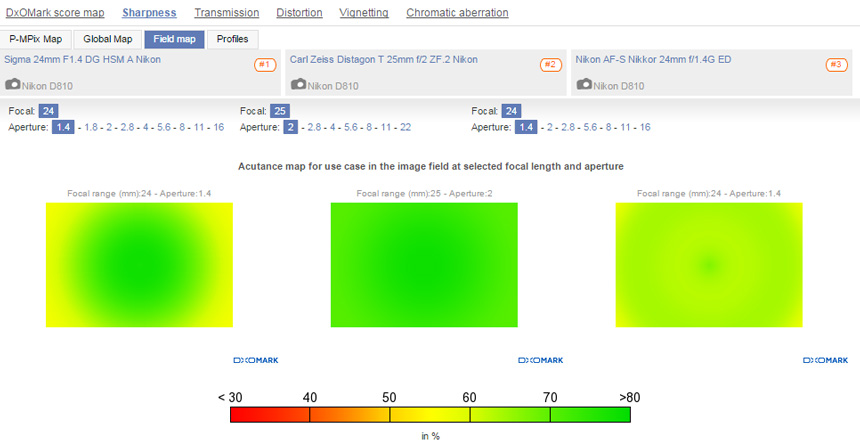
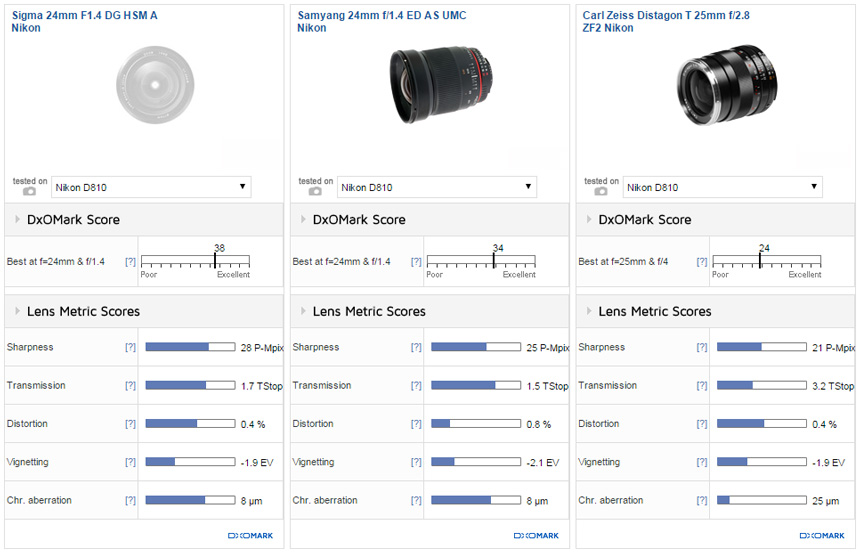
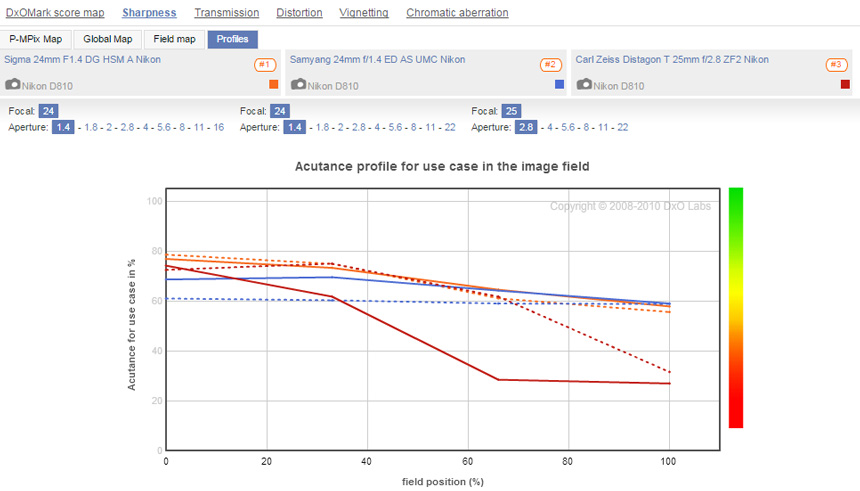
DXOMARK encourages its readers to share comments on the articles. To read or post comments, Disqus cookies are required. Change your Cookies Preferences and read more about our Comment Policy.